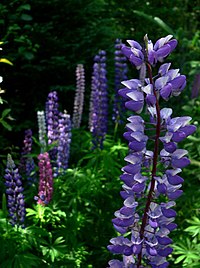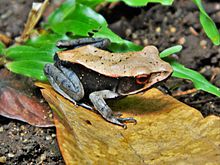Native species

In biogeography, a native species is indigenous to a given region or ecosystem if its presence in that region is the result of only local natural evolution (though often popularised as "with no human intervention") during history.[1] The term is equivalent to the concept of indigenous or autochthonous species.[2][3] A wild organism (as opposed to a domesticated organism) is known as an introduced species within the regions where it was anthropogenically introduced.[4] If an introduced species causes substantial ecological, environmental, and/or economic damage, it may be regarded more specifically as an invasive species.
The notion of nativity is often a blurred concept, as it is a function of both time and political boundaries.
A native species in a location is not necessarily also endemic to that location. Endemic species are exclusively found in a particular place.[8] A native species may occur in areas other than the one under consideration. The terms endemic and native also do not imply that an organism necessarily first originated or evolved where it is currently found.[9]
Ecology

Native species form communities and biological interactions with other specific flora, fauna, fungi, and other organisms. For example, some plant species can only reproduce with a continued mutualistic interaction with a certain animal pollinator, and the pollinating animal may also be dependent on that plant species for a food source.[10] Many species have adapted to very limited, unusual, or harsh conditions, such as cold climates or frequent wildfires.[11] Others can live in diverse areas or adapt well to different surroundings.
Human impact and intervention
The diversity of species across many parts of the world exists only because bioregions are separated by barriers, particularly large rivers, seas, oceans, mountains, and deserts. Humans can introduce species that have never met in their evolutionary history, on varying time scales ranging from days to decades (Long, 1981; Vermeij, 1991). Humans are moving species across the globe at an unprecedented rate. Those working to address invasive species view this as an increased risk to native species.
As humans
Conservation and advocacy
Native plant organizations such as the Society for Ecological Restoration, native plant societies,[13] Wild Ones, and Lady Bird Johnson Wildflower Center[14] encourage the use of native plants. The identification of local remnant natural areas provides a basis for this work.
Many books have been written on the subject of planting native plants in home gardens.[15][16][17] The use of cultivars derived from native species is a widely disputed practice among native plant advocates.[18]
Importance of nativity in conservation
When
See also
References
- ^ "Executive Order 13112". 2008-05-15. Archived from the original on 15 May 2008. Retrieved 2022-07-09.
- ^ "What are native plants?". University of Rhode Island. Retrieved 16 January 2019.
- ^ "Autochthonous". Merriam-Webster.com Dictionary. Retrieved 16 January 2019.
- ^ "Introduced species". Science Daily. Retrieved 26 December 2017.
- ISBN 9780128092989.
- ISBN 9781351163545.
- S2CID 246251260.
- ^ "Endemic". Oxford English Dictionary (Online ed.). Oxford University Press. (Subscription or participating institution membership required.)
- ^ Indigenous, Aliens and Invasives Envirofacts
- ISBN 978-0-88192-854-9.
- ISSN 0028-646X.
- ^ "Point Reyes National Seashore, Drakes Estero, A Sheltered Wilderness Estuary", National Park Service, United States Department of the Interior, p. 16.
- ^ "Native Plant Societies". nanps.org. Retrieved 2018-09-23.
- ^ "Lady Bird Johnson Wildflower Center". Wildflower.org. Retrieved 2012-07-09.
- ISBN 9780395709405.
- ISBN 9780809226658.
- ISBN 978-1604699005.
- ^ ""Nativars" Courtesy of Watermarkwoods.com". Archived from the original on 2016-03-04. Retrieved 2014-07-09.
- ^ Travis Longcore, Rudi Mattoni, Gordon Pratt, and Catherine Rich, "On the perils of ecological restoration and the El Segundo blue butterfly", in press, for 2nd Interface Between Ecology and Land Development in California. Occidental College, April 18-19, 1997 Online.
- ^ "Black, S. H., and D. M. Vaughan, "Species profile: Euphilotes battoides allyni, El Segundo Blue", Red List of Pollinator Insects of North America. CD - ROM Version 1 (May 2005). Portland, OR: The Xerces Society for Invertebrate Conservation. (2005)" (PDF). Archived from the original (PDF) on 2016-03-03. Retrieved 2013-09-29.
- ^ ""California's butterflies: The El Segundo Blue", Quino Checkerspot Captive Breeding Program, Vista Murrieta High School. O line". Archived from the original on 2013-10-02. Retrieved 2013-09-29.
Further reading
- Chris D. Thomas (2017). Inheritors of the Earth: How Nature Is Thriving in an Age of Extinction. PublicAffairs. ISBN 978-1610397278.
